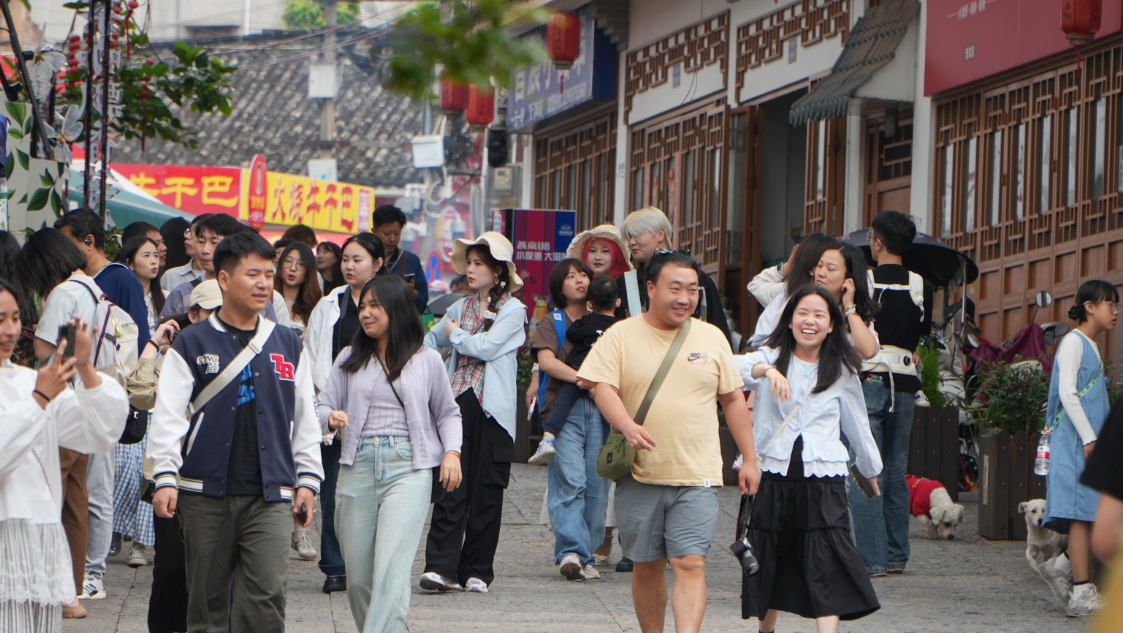May Day holiday consumption mirrors the breadth and depth of China’s economy

Travel boom is seen during the May Day holiday in Pu'er city, southwest China's Yunnan province. Photo/Yunnan Daily
During this year's May Day holiday, China's consumer market unleashed renewed and robust vitality. Data from the Ministry of Transport shows that, from May 1 to 5, the total cross-regional passenger traffic nationwide is expected to reach 1.467 billion trips, averaging 293 million trips per day - an 8.0 percent year-on-year increase. Passenger volumes by rail, road, water and air all saw a marked rise. According to the Ministry of Commerce, sales from major retail and catering businesses across China saw a year-over-year increase of 6.3 percent during the holiday. The twin boom in travel and consumption not only ignited the holiday economy but also revealed the depth and vast potential of China's economic development.
While traditional tourist hotspots unsurprisingly saw huge crowds, many people opted for "reverse travel," making tourism in smaller cities a new highlight of consumption. In addition to Rongchang district, Southwest China's Chongqing Municipality, which gained widespread attention by receiving 2.24 million visitors and selling 290,000 marinated geese in just five days, non-traditional destinations such as Tongling in Anhui, Yichun in Jiangxi, and Tongliao in Inner Mongolia also witnessed peak visitor flows. Data shows that from May 1 to 4, Douyin group-buying orders for lodging and dining in Tongling surged 491 percent year-on-year. Orders in Yichun and Xuancheng in Anhui more than tripled, while Shangrao in Jiangxi, Tongliao in Inner Mongolia and Lingshui in Hainan recorded year-on-year increases of 170 percent, 169 percent and 147 percent respectively. According to Trip.com's 2025 May Day Big Data Forecast Report, tourism activity in county-level markets increased by 25 percent year-on-year during the holiday, outpacing that of major cities by 11 percentage points.
From the rise of "village super league" and "village basketball association," or "village BA," over the past two years, to the unexpected popularity of Zibo barbecue and Tianshui malatang - and now to Rongchang, Tongliao and other small cities stepping into the spotlight of China's cultural tourism stage - a clear trend is emerging. China's vast territory is home to countless once-overlooked towns that are now gaining new opportunities, made possible by improvements in infrastructure. For instance, internet video platforms enable small businesses to reach customers more precisely, helping small cities achieve economic breakthroughs; the expansion of the high-speed rail network and the widespread use of electric vehicles have made spontaneous travel a reality. China's economic growth drivers are extending from first- and second-tier cities to the broader markets of third- and fourth-tier cities and counties. Regional coordinated development policies are bearing fruit, reflecting the breadth, depth and multi-layered potential of China's domestic demand.
Meanwhile, more foreign tourists are also flocking to smaller cities. Boosted by favorable policies such as visa-free transit and instant tax refunds, inbound travel orders surged 173 percent year-on-year during the May Day holiday period. While Beijing, Shanghai, Guangzhou, Shenzhen and Hangzhou remain key destinations, more international travelers are beginning to explore distinctive small cities such as Jingdezhen, Tianshui and Zhoushan. With the emergence of new business models such as "technology + nature + culture" and "agriculture + intangible cultural heritage" in various regions, agricultural experiences and "China Shopping" have also become popular attractions for foreign tourists. It can be said that each "small town story" serves as a window into observing the high-quality development of the Chinese economy. As China continues to open up, "China Travel" has transformed from merely an experience into a lifestyle that allows people to feel and fall in love with China.
In fact, it's not just "county tourism." The emergence of new forms of travel, such as "new silver-haired tourism," "neo-Chinese-style tourism," "shopping tourism," "reverse tourism," and "concert tourism," showcases the immense demand and vibrant innovation within the Chinese market to the world. The prosperity of cultural tourism market reflects the strong drive of people's pursuit of a better life, as well as the comprehensive progress China has achieved in the global consumer market to meet this pursuit. It not only creates more consumption hotspots and economic growth points, promoting further upgrade of related production and industrial chains, but also mirrors the tremendous potential and depth of the Chinese market, providing vast imagination space for the further release of future market potential.
From the eastern coastal regions to small towns in the central and western parts of China, and from traditional manufacturing to emerging service industries, the multi-layered structure of the Chinese economy provides a "buffer zone" to withstand external risks while also creating a "testing ground" for innovation and growth. The vast market of over 1.4 billion people in China, the ongoing upgrade of consumption, and the new type of urbanization vividly illustrate that "the Chinese economy is not a pond, but an ocean." Amid unprecedented turbulence in the global trade environment, this ancient land of China continues to emit new attractions. It is China's more open stance in welcoming the global consumer market that encourages both domestic and foreign tourists to place their trust in the Chinese market.
The Chinese economy holds unlimited possibilities, and even more surprises are expected to emerge in the future. Whether in modern cities or small towns full of local flavor, each is uniquely telling its own story and showcasing China's charm. As more policy innovations resonate with market vitality in the future, the Chinese economy will steadily progress along the path of high-quality development and continue to inject more "Chinese momentum" into global prosperity.